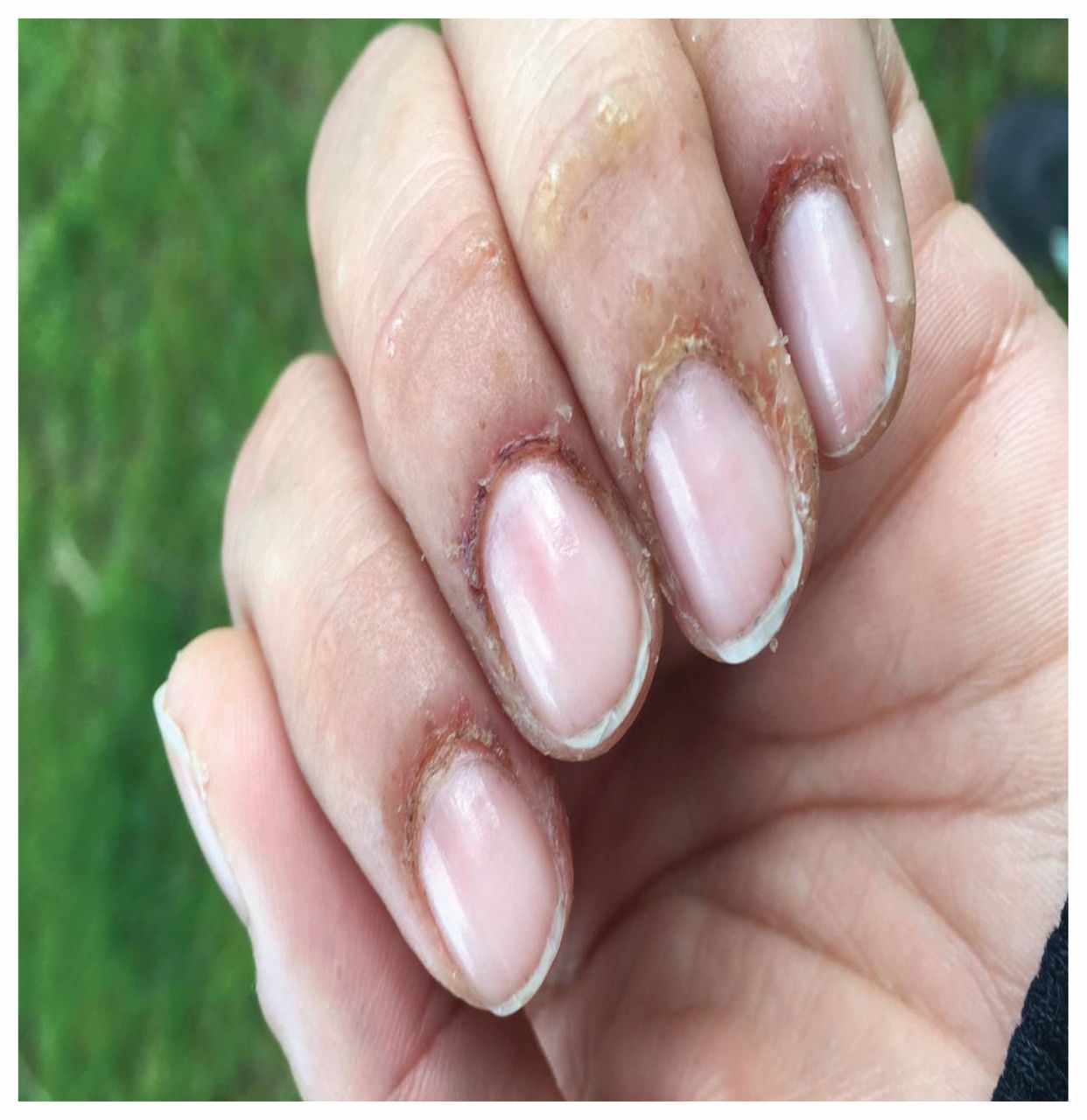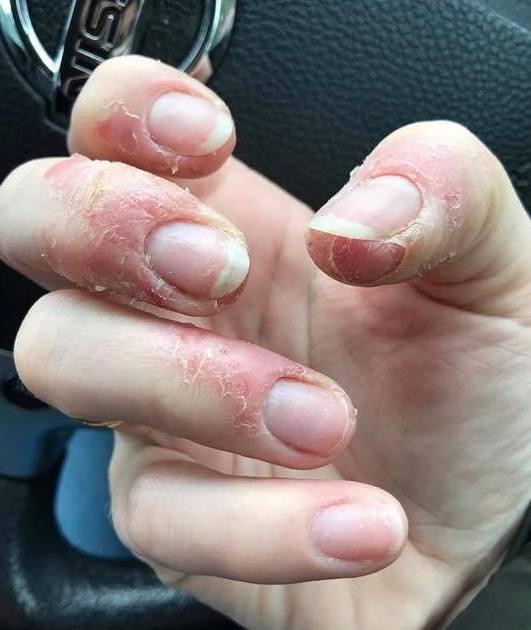Is the condition of your nails whispering tales of irritation and discomfort? Contact dermatitis nails, a condition where the nails become the unwilling canvas for an inflammatory response, can significantly disrupt the simple joys of everyday life, from applying nail polish to simply washing your hands. The subtle changes, the itching, the potential for pain all speak to an underlying sensitivity that deserves understanding and attention. It's a topic rarely discussed yet profoundly impactful, forcing us to confront a realm where beauty and health intersect, often with unexpected consequences.
The realm of contact dermatitis nails is complex, an intricate dance between the nails themselves and the substances they encounter. Imagine the nail plate, once a smooth, strong barrier, now exhibiting signs of distress: redness around the nail bed, swelling, even blistering. The causes are diverse, ranging from the common irritants found in everyday products to allergic reactions triggered by more specific ingredients. The symptoms, too, vary depending on the offending agent and the individual's sensitivity.
But what exactly constitutes contact dermatitis nails? It is a form of contact dermatitis, a skin condition that arises from direct contact with an irritant or allergen. When this inflammation specifically targets the nails, or the skin surrounding them, the nails become the focal point of the reaction. This sensitivity can stem from a wide array of sources, from the obvious suspects like nail polish, artificial nails, and their associated adhesives, to less-obvious culprits like cleaning products, hand sanitizers, and even certain medications. The nails, though seemingly impervious, are not immune. They are an integral part of the body and are susceptible to the impact of external factors. The nail bed, nail matrix, and surrounding skin are all vulnerable and react to irritants and allergens. Understanding the mechanisms behind this is essential to effective diagnosis and treatment.
- October 17 Zodiac Libra Traits Compatibility Horoscope Insights
- Red Scare Podcast Anna Khachiyan Dasha Nekrasova Explained
The primary causes are often divided into two broad categories: irritant contact dermatitis and allergic contact dermatitis. Irritant contact dermatitis occurs when a substance directly damages the nail or the surrounding skin, leading to inflammation. This can happen after repeated exposure to harsh chemicals, or abrasive products, or even prolonged exposure to water. Allergic contact dermatitis, on the other hand, is an immune response. The body's immune system misidentifies a harmless substance as a threat and launches an attack, resulting in an allergic reaction. This type of reaction can be triggered by a variety of ingredients, some of which are commonly found in nail products. The symptoms can range from mild redness and itching to severe blistering and pain. The severity of the reaction will depend on the individual and the substance involved.
One of the most prevalent culprits in contact dermatitis nails is the complex world of nail products themselves. Nail polish, both conventional and gel varieties, can contain a host of chemicals that can trigger reactions. Formaldehyde, a known irritant and potential allergen, is often found in older formulas, while toluene, dibutyl phthalate (DBP), and camphor are other offenders. Even products marketed as "3-free," "5-free," or "7-free" may still contain ingredients that can cause problems for sensitive individuals. Artificial nails, whether acrylic, gel, or press-on, can also cause significant problems. The adhesives, primers, and monomers used to attach these artificial nails often contain chemicals that cause irritation or allergic reactions. These materials can leak around the edges of the nail, making the skin exposed to a constant assault from irritants and allergens. The process of applying or removing artificial nails can also cause physical trauma that makes the nails more susceptible to damage.
Beyond the beauty salon, everyday items like cleaning products, hand sanitizers, and soaps also pose risks. Many cleaning products contain harsh chemicals and detergents that can irritate the skin and nails, especially with frequent use. Hand sanitizers, particularly those with high alcohol content or added fragrances, can dry out the skin and lead to inflammation. Even something as seemingly innocuous as soap can cause problems. Soaps containing fragrances, preservatives, or other additives can trigger contact dermatitis in sensitive individuals. Moreover, frequent handwashing, though crucial for hygiene, can strip the skin and nails of their natural oils, making them more vulnerable to irritants and allergens.
- Hallie Gnatovich Josh Gates From Destination Truth To Divorce
- Dear Daniel Hello Kittys Boyfriend History Facts More
The diagnosis of contact dermatitis nails relies on a combination of careful observation and medical expertise. A dermatologist will typically start by taking a thorough medical history, inquiring about the patient's exposure to potential irritants or allergens. The dermatologist will examine the affected nails and skin, looking for signs of inflammation, such as redness, swelling, blistering, and scaling. Patch testing, the gold standard for diagnosing allergic contact dermatitis, involves applying small amounts of suspected allergens to the skin under patches. These patches remain in place for 48 hours, then are removed, and the skin is examined for any reaction. This helps to identify the specific allergens that are triggering the reaction. In some cases, a nail biopsy might be performed to examine the tissue under a microscope. This can help rule out other conditions and confirm the diagnosis.
The treatment for contact dermatitis nails aims to alleviate symptoms, prevent further exposure to irritants or allergens, and promote healing. Avoiding the offending substance is the cornerstone of treatment. This may involve discontinuing the use of certain nail products, switching to hypoallergenic alternatives, or modifying habits like frequent handwashing. Topical corticosteroids, such as creams or ointments, can help reduce inflammation and relieve itching. In more severe cases, oral corticosteroids or other medications might be necessary. Moisturizing the affected nails and skin is also crucial. Regular application of emollients, such as petroleum jelly or thick creams, helps to hydrate the skin and promote healing. Protecting the nails from further irritation, such as wearing gloves when handling harsh chemicals or washing dishes, is also important.
Prevention is crucial. Choose hypoallergenic nail products, and look for products that are free of common allergens. Always read ingredient lists carefully, and be aware of the potential for reactions. Limit your exposure to harsh chemicals, such as those found in cleaning products and solvents. Wear gloves when handling these products. Protect your hands and nails from excessive moisture. Wash your hands with mild, fragrance-free soaps. Moisturize your hands and nails regularly. If you suspect contact dermatitis, seek professional medical attention promptly. Early diagnosis and treatment can help prevent the condition from becoming chronic.
Contact dermatitis nails is a condition that varies significantly from person to person. Factors such as an individual's sensitivity, the specific irritant or allergen involved, the duration of exposure, and the overall health of the nails all influence the severity of the reaction. Some individuals may experience mild irritation, while others develop severe inflammation and blistering. It's worth noting that repeated exposure to an irritant or allergen can increase sensitivity over time. What might cause minimal problems initially could trigger a more severe reaction with repeated contact. Understanding the underlying mechanisms and individual vulnerabilities is paramount for effective management.
The long-term prognosis for contact dermatitis nails is generally good, provided the offending irritant or allergen is identified and avoided. Many individuals experience complete resolution of symptoms once they remove the source of the irritation. However, some individuals may develop chronic contact dermatitis, particularly if they are repeatedly exposed to the irritant or allergen or if they have other underlying skin conditions. In these cases, ongoing management, including topical corticosteroids, moisturizers, and avoiding triggers, may be necessary to control symptoms.
The journey through the world of contact dermatitis nails underscores the importance of mindful awareness in daily life. Paying attention to the products we use, the environments we inhabit, and the signals our bodies send is crucial. Seeking professional medical advice when symptoms arise and implementing preventative measures can lead to a path of healthier nails and overall well-being. The interplay between beauty, hygiene, and sensitivity is a constant reminder of the need for knowledge, vigilance, and proactive care.
- Miley Cyrus Siblings A Complete Guide To Her 5 Brothers Sisters
- United Employee Flight Benefits Your Guide Starts Here


